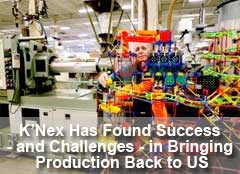From SCDigest's On-Target E-Magazine
- March 12, 2013 -
Supply Chain News: Another US Company Brings Manufacturing Back Home - and this Time It Is Surprisingly a Toy Maker
K'Nex Sees Opportunity for Faster Responsiveness, but there are Challenges; Finding Suppliers is Hard
SCDigest Editorial Staff
It is generally believed that at least some US manufacturing is moving back home, or staying here rather than moving offshore, as higher costs in China, market responsiveness and other factors have tipped the scales so that they are more in balance for US production.
The evidence so far has been mostly anecdotal, though in general US manufacturing has been an economic bright spot in an otherwise weak recovery since the bottom of the recession in 2009, perhaps supporting the trend with some hard data. But most of the anecdotal examples have come from US manufacturers building complex machinery or devices, companies such as NCR, Caterpillar, Whirlpool and others, not the low-value added products that were generally the first to move offshore in the 1990s or even before.
SCDigest Says: |
 |
To help keep costs down, the company also recently acquired one of the new Baxter robots from Rethink Robotics for some packaging tasks. |
|
What Do You Say?
|
|
|
|
The toy category is certainly one of those, with toy manufacturing coming close to almost disappearing from US soil, primarily to China, which has come to dominate toy production globally. One stat from the industry said that in 2011, 86% of the entire world's toy production was done in China. In 2012, US imports of toys, games and sporting goods, mostly from China, totaled $33.5 billion, or about three times US exports of such items, according to government statistics, and it is likely that toys were a smallish portion of that total.
That as the toy industry generally has been struggling against electronic games and other alternatives to traditional toys.
So a fresh article in the Wall Street Journal noting that toy maker K'Nex Brands - a maker of a family of mostly "connect and build" toy sets, such as K'Nex, Lincoln Logs, and Tinker Toys - has nearly completed a US re-shoring strategy.
The family-owned, $100 million manufacturer cited market responsiveness as the main driver of the change, as well as better control of quality and materials, which impact customer satisfaction and safety.
"In the long term, it's much better for us to manufacture here," Joel Glickman, chairman of K'Nex and its manufacturing affiliate, Rodon Group, told the Wall Street Journal.
The move of production back to Rodon's factory in Hatfield, PA required rethinking product design in some cases and even a bit of "outsourcing to the customer" - having kids or their parents perform some of the assembly work that was previously done as part of the manufacturing process, reducing labor content.
But while it has a goal of moving 100% of its production back to the US, the company is finding many challenges. As others trying to keep or bring back production to the US have reported, perhaps the chief issue is finding suppliers. China's global dominance in toys means there are probably thousands of suppliers for toy parts and pieces. With toy manufacturing, especially for plastic toys, having left the US in droves over the past 20 years, the toy supply base has been similarly devastated.
"In China, you can go over with just a drawing and say, 'I need a million of these,'" Michael Araten, K'nex's CEO, told the Journal. In the US, finding qualified and capable vendors is now a much harder proposition.
 The company, founded in 1956, had moved most of its toy production to China by the late 1990s. But the Rodon arm still made other products for customers, such as coffee filters and plastic parts for windows, that could be produced using highly automated processes. But when the recession came in 20008, demand for those items fell dramatically, and the reshoring effort started in large part as a way to keep current factory workers busy. The company, founded in 1956, had moved most of its toy production to China by the late 1990s. But the Rodon arm still made other products for customers, such as coffee filters and plastic parts for windows, that could be produced using highly automated processes. But when the recession came in 20008, demand for those items fell dramatically, and the reshoring effort started in large part as a way to keep current factory workers busy.
It was a test for Rodon, whose slogan is "Cheaper Than China." It redesigned its products to reduce labor requirements, such as changes to plastic track components that enabled them to be snapped together rather than using a pin inserted by hand in China. Other parts became part of the user-assembly process that were previously added by Chinese workers.
An attractive shiny paint finish on some of its cars that run on the tracks is going away too, due to cost and environmental reasons, likely to be replaced with decals.
"We can't do it here, so we designed it out of the product," another K'Nex executive said.
The wooden Lincoln Logs are still made in China, but the company says it hopes to find a US source soon. The same story for small battery-powered motors used with the K'Nex products, which are still sourced from China because the company can't find a competitive US supplier.
(Manufacturing Article Continued Below)
|